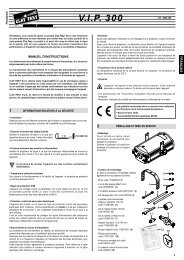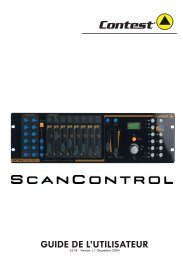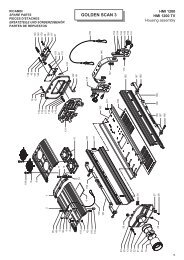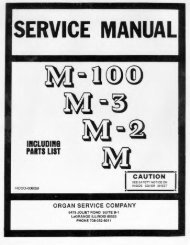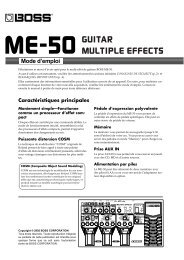Create successful ePaper yourself
Turn your PDF publications into a flip-book with our unique Google optimized e-Paper software.
The Algorithms and their Parameters"Split" SetupAlgorithmsThe Dual Delay algorithm consists of 2 types of delay lines: Gliding Flangedelays and Fixed delays. This is a true stereo algorithm. (If run in a Dual Monosetup, however, it will be mono.)Dual DelaysGeneral DescriptionTwo independet gliding flange predelays are available, each with a 20ms rangein single sample steps. There is also a ganged stereo gliding flange delay. Thereare two flange gain controls which vary the overall amount of flange effect.The flange glides are typically modulated by the internal LFO. Setting the flangegains very high will cause an “over the top” type of flange to occur as the flangeglide delays cross over the predelay pointers. The outputs of the flange delaysare fed to the delay left and delay right lines which are 2.5 seconds long. Onceinto these delay lines, you can create many different delay effects. There are twoprogrammable taps on each delay line. DLY1 (left) and DLY2 (right) can beprogrammed anywhere along this 2.5 second path. There will, however, be noapparant delay unless a feedback value is assigned to the delay values via FBK1and FBK2. All Pass filters, or diffusors, in line with the feedback paths are labeledAPD (All Pass Delay) and APG (All Pass Gain). The actual “tuning” of the All passdelay is accomplished with the APD control. The amount of diffusion is set byAPG. When APG is turned high and FBK1 is adjusted away from the 0% value,each feedback loop will be rediffused.DLY3 and DLY4 are cross feedback delay lines. They are also adjustableanywhere along the 2.5 second delay line. DLY3 feeds from the left delayposition to the input of the right delay line. The same is true with DLY4 feedinginto the left delay line. The feedback parameters adjust the amount (level)passed into the destination delay lines.The last pair of delay pointers (LDLY and RDLY) can be thought of asindependently adjustable post delays. These can be adjusted anywhere alongthe 2.5 second delay line.The output of each delay line can be positioned anywhere in the stereo pan field.LPAN adjusts the position of the left delay loop; RPAN positions the output of theright delay loop.4-23






